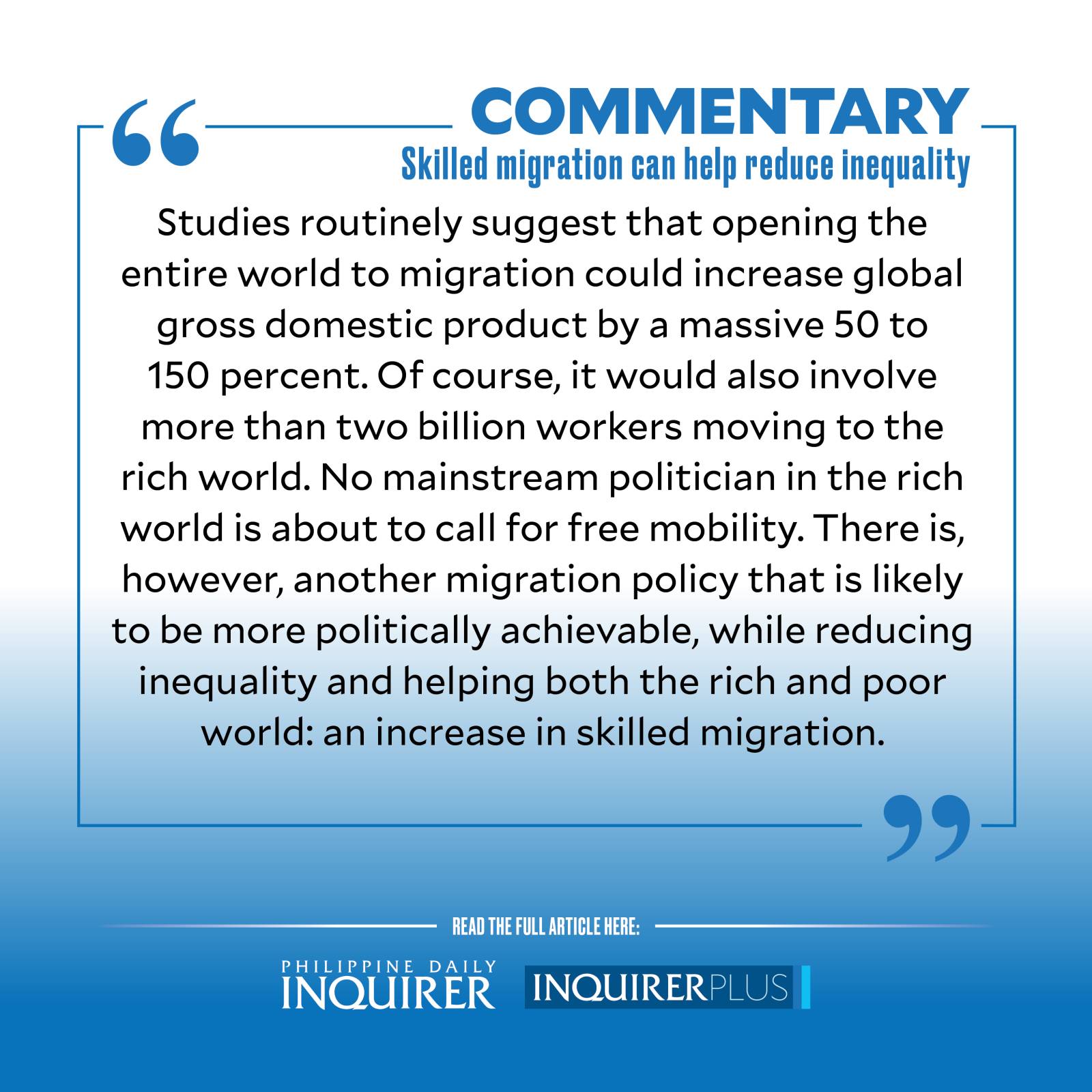Skilled migration can help reduce inequality

If politicians were truly serious about ending global inequality, many economists would say there is one obvious policy: Allow greater global migration. A nurse is paid about $1,900 a year in poor countries and about $32,000 in rich countries. A Mcdonald’s worker in India earns 16 times less than their counterpart doing the same job in the United States. Economic theory holds that most of the world’s poor could become much more productive and much richer if they were allowed to move to the developed world.
Studies routinely suggest that opening the entire world to migration could increase global gross domestic product by a massive 50 to 150 percent. Of course, it would also involve more than two billion workers moving to the rich world. No mainstream politician in the rich world is about to call for free mobility. There is, however, another migration policy that is likely to be more politically achievable, while reducing inequality and helping both the rich and poor world: an increase in skilled migration.
For many years, my think tank, the Copenhagen Consensus, has worked with several Nobel laureates and more than a hundred leading economists to look at ways governments allocate money to do good for the world and to establish where each peso is most effectively spent.
This work has been driven by the failure of the world’s governments to actually reach their promises. In the United Nation’s Global Goals, all the world’s nations have made extravagant promises for 2030 across nearly every agenda. This year, we are at halftime for these promises, but we are far from halfway to delivery. On our current trajectory, even with very optimistic assumptions, we’re likely to achieve the goals at least half a century late.
This means the world needs to start prioritizing. As we’re clearly unable to deliver on everything we have promised, maybe we should start with the most effective policies first. New research for Copenhagen Consensus identifies 12 incredibly effective policies that could deliver huge benefits at moderate costs. Smart migration is one such policy, especially for its impact on reducing inequality.
Enabling more skilled migration to countries that need more skilled labor could achieve both higher productivity and less inequality. And surveys tend to suggest it’s more politically viable, as skilled migration is less divisive than overall migration.
Our new study on migration looks at the impacts of allowing more skilled migration, particularly of doctors and science, technology, engineering, and math (STEM) workers.
In total, the world today has about 37 million skilled migrants. STEM workers comprise about nine million of these, and medical doctors about one million. Compare this to the fact that the world has just 13 million doctors in total, with 160,000 in the Philippines.
What would happen if each nation took in 10 percent more skilled migrants from the same mix of countries they already have?
Migrants themselves would clearly benefit. A doctor moving from the Caribbean or Central America to the US, for example, will see a dramatic and sustained increase in wages, worth almost $1.6 million. But countries receiving skilled migrants, including the US, would also see benefits: Specialized doctors will fill available positions so that less specialized doctors or nurses can go back to doing what they do best, and there is likely to be slightly higher economic growth. This is because introducing more diverse ways of thinking, doing things, and approaching problems can generate more innovation which drives growth. Recipient countries can also gain a skilled worker without incurring the costs of a lengthy, costly education.
Less obviously, countries, where migrants originate, will also see more benefits than costs. Often, we just focus on the so-called “brain drain” that forces the country to pay to educate new doctors, while lowering the productivity of the doctors who remain.
But the new research shows these costs will be outweighed by the fact that skilled migrants who leave will establish new and additional channels for trade, investment, and production that can boost their home countries. Moreover, they will also send home substantial and regular remittances, enabling their extended family to pay for good things like more education and productivity. In total, these benefits will likely outweigh the costs about two-to-one.
Globally, the overall benefits to everyone will be much higher than the costs. While the total costs add up over the next 25 years to about $55 billion, the benefits will add up to almost a trillion dollars. This means that each dollar spent on the policy will deliver a substantial $18 of social benefit globally, which will mostly flow to the world’s poorer nations.The research shows that increasing skilled migration at a global level offers a real opportunity to address inequality and increase global productivity. If the world is far behind on almost all its promises, maybe we should focus on the most effective policies first. Allowing more skilled migration where needed could be just one such policy.
—————–
Dr. Bjorn Lomborg is president of the Copenhagen Consensus and visiting fellow at Stanford University’s Hoover Institution.
—————–
This is part of an Inquirer-exclusive series from the Copenhagen Consensus Center on the Sustainable Development Goals.




















